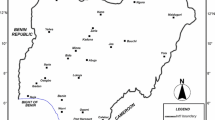Abstract
The contributions of twelve independent factors/variables to the magnitude of the local diurnal temperature range (DTR) in Israel were examined, and five to seven were found to contribute significantly. Israel was chosen due to its complex terrain with several climatic zones and proximity to the Mediterranean Sea. The seven sites for this study represent different terrains, from mountainous with a Mediterranean climate to desert. Each site had 6 years of data available. Stepwise analysis was performed in order to determine the contribution of each factor/variable at each site. The linear correlations between the DTR and each factor were calculated. These were carried out at each site for the whole year and for each season, separately. Relative humidity was found to have the largest DTR contribution at all sites, for 3 seasons, except summer at shoreline sites and in Jerusalem. The daily cloud cover and the wind speed had small contributions in most sites. The magnitude of the DTR was found to vary largely with location and to be considerably smaller in the seashore sites than those inland.





Similar content being viewed by others
References
Alpert P, Osetinsky I, Ziv B, Shafir H (2004) A new seasons definition based on the classified daily synoptic systems: an example for the Eastern Mediterranean. Int J Climatol 24:1013–1021
Braganza K, Karoly DJ, Arblaster M (2004) Diurnal temperature range as an index of global climate change during the twentieth century. Geophy Res Let 31(13):4. https://doi.org/10.1029/2004GL019998
Dai A, Trenberth KE, Karl TR (1999) Effects of clouds, soil moisture, precipitation and water vapor on diurnal temperature range. J Clim 12:2451–2473
Davy R, Esau I, Chernokulsky A, Outten S, Zilitinkevich S (2016) Diurnal asymmetry to the observed global warming. Int J Climatol 37:79–93. https://doi.org/10.1002/joc.4688
Easterling DR, Horton B, Jones DJ, Peterson TC, Karl TR, Parker DE, Salinger MJ, Razuvayev V, Plummer N, Jameson P, Folland CK (1997) Maximum and minimum temperature trends for the globe. Science 277:364–367
Forster M de F, Solomon S (2003) Observations of a “weekend effect” in diurnal temperature range, Proceedings of the National Academy of Sciences of the USA, ed. by Hansen JE. Goddard Institute of Space Studies New York NY.
Gallo KP, Easterling DR, Peterson TC (1996) The influence of land use and land cover on climatological values of the diurnal temperature range. J Clim 9(11):2941–2944
Karl TR, Kukla G, Gavin J (1984) Decreasing diurnal temperature range in the United States and Canada from 1941 through 1980. J Clim Appl Met 23(11):1489–1504
Makovsky K, Wild M, Ohmura A (2008) Diurnal temperature range over Europe between 1950 and 2005. Atmos Chem Phys 8:6483–6498
Price C, Michaelides S, Pashiardis S, Alpert P (1999) Long term changes in diurnal temperature range in Cyprus. Atm Research 51:85–98
Qu M, Wan J, Ha X (2014) Analysis of diurnal temperature range in the continental United States, Weath. Clim Extremes 4:86–95
Remar A, advisor Preston W (2010) Urban heat island expansion in the greater Las Vegas metropolitan area. California Polytechnic state university, San Louis Obispo
Rohde R, Muller RA, Jacobsen R, Muller E, Perlmutter S, Rosenfeld A, Wurtele J, Groom D, Wickham C (2013) A new estimate of the average earth surface land temperature spanning 1753 to 2011. Geoinformatics & Geostatistics 1(1):7. https://doi.org/10.4172/2327-4581.1000101
Stone DA, Weaver AJ (2002) Daily maximum and minimum temperature trends in a climate model. Geophy. Res. Let. 29(9):1356. https://doi.org/10.1029/2001GL014556
Stone D, Weaver A (2003) Factors contributing to diurnal temperature range trends in twentieth and twenty-first century simulations of the CCCma coupled model. Clim Dyn 20:435. https://doi.org/10.1007/s00382-002-0288-y
Acknowledgments
The authors wish to thank to the Israeli Meteorological Service for the data and to Dr. Alexandra Chudnovsky and Ms. Maaian Rothstein for their helpful comments.
Funding
The German Helmholtz Association is gratefully acknowledged for (partly) funding this project within the Virtual Institute DESERVE (Dead Sea Research Venue) under contract number VH-VI-527. The authors thank the ISF (grant no. 1123/17) for their support.
Author information
Authors and Affiliations
Corresponding author
Additional information
Publisher’s note
Springer Nature remains neutral with regard to jurisdictional claims in published maps and institutional affiliations.
Unfortunately the lead author Dr. Joseph Barkan passed away during the final revision on 7 June 2019. This paper is dedicated to his blessed memory.
Rights and permissions
About this article
Cite this article
Barkan, J., Shafir, H. & Alpert, P. Multi-factor analysis of DTR variability over Israel in the sea/desert border. Theor Appl Climatol 139, 287–295 (2020). https://doi.org/10.1007/s00704-019-02958-x
Received:
Accepted:
Published:
Issue Date:
DOI: https://doi.org/10.1007/s00704-019-02958-x




